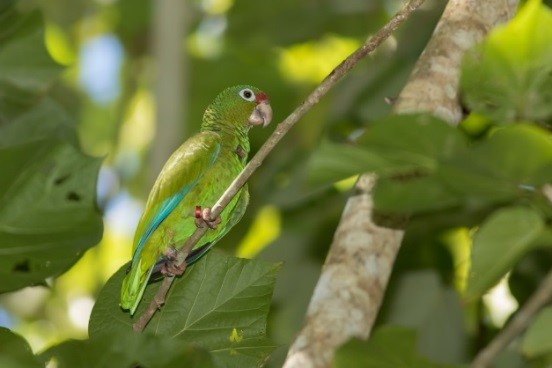Birdfinding.info ⇒ Río Abajo State Forest is the only site where free-flying Puerto Rican Parrots can be expected. They are often found in the vicinity of the captive breeding facility. To protect the species from trappers, access to the area is sometimes restricted, so it is generally recommended to contact the forest office in advance and request permission to visit.
Puerto Rican Parrot
Amazona vittata
Critically endangered Puerto Rican endemic that is confined to two protected tracts of rain forest, El Yunque National Forest and Río Abajo State Forest, only occasionally wandering to adjacent areas. Far more numerous at Río Abajo.
Formerly common throughout Puerto Rico and adjacent islands, but it was persecuted to the brink of extinction. (See Decline and Recovery of the Puerto Rican Parrot in Notes, below.)
Identification
The only parrot native to Puerto Rico, but now one of three or more Amazona species found on the island.
At a distance, appears all-green with broad white eye-rings. With a clearer view, shows a vivid red forehead patch, blue on the wings, and in some individuals red around the chin.
In flight, its wings appear mostly blue, with no red or orange patch, which separates it from the introduced species present. (Note that the Hispaniolan Parrot also has blue wings and has existed ferally on Puerto Rico at times, but it seems to have vanished from the island.)
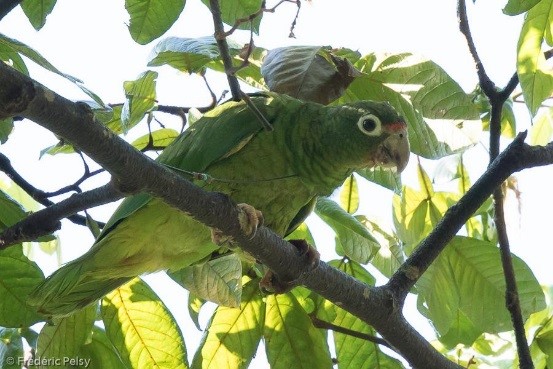
Puerto Rican Parrot. (Río Abajo State Forest, Puerto Rico; March 22, 2017.) © Frédéric Pelsy
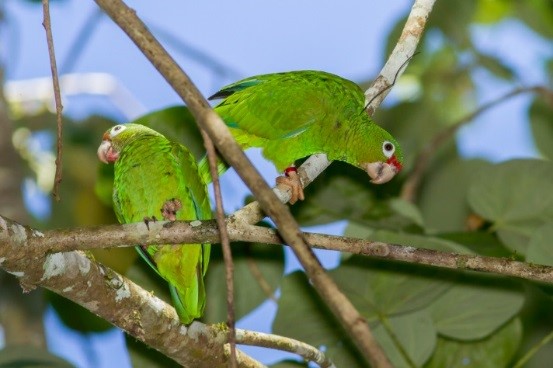
Puerto Rican Parrot. (Río Abajo State Forest, Puerto Rico; March 22, 2015.) © Tom Johnson
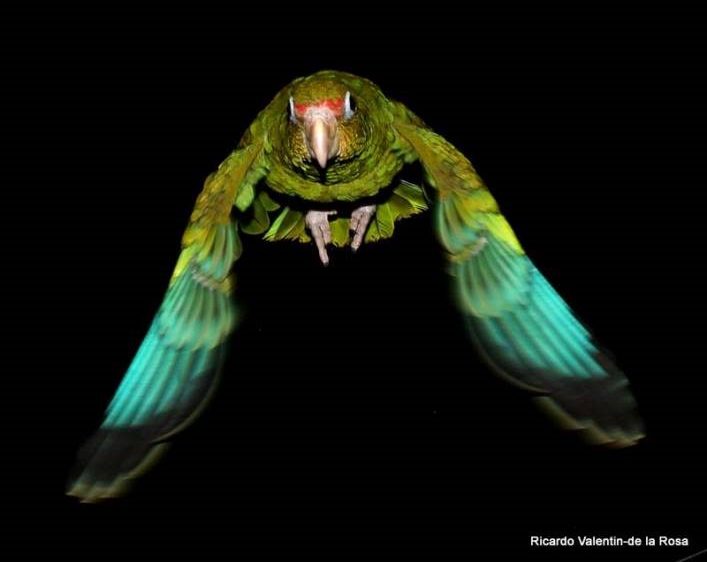
Puerto Rican Parrot, in flight, showing extent of turquoise coloration in wings. (Iguaca Aviary, Río Abajo State Forest, Puerto Rico; 2013.) © Ricardo Valentín-de la Rosa
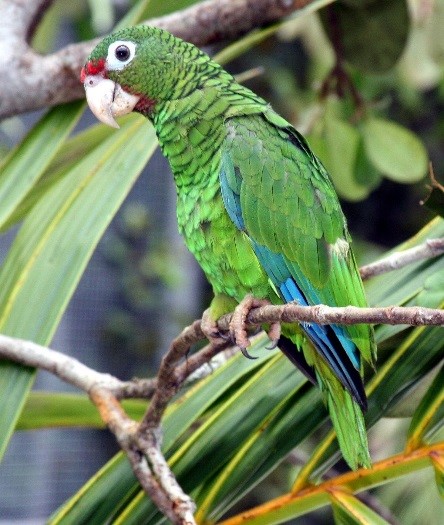
Puerto Rican Parrot. (Iguaca Aviary, Río Abajo State Forest, Puerto Rico; April 28, 2007.) © Tom MacKenzie

Puerto Rican Parrot. (Río Abajo State Forest, Puerto Rico.) © Benny Diaz
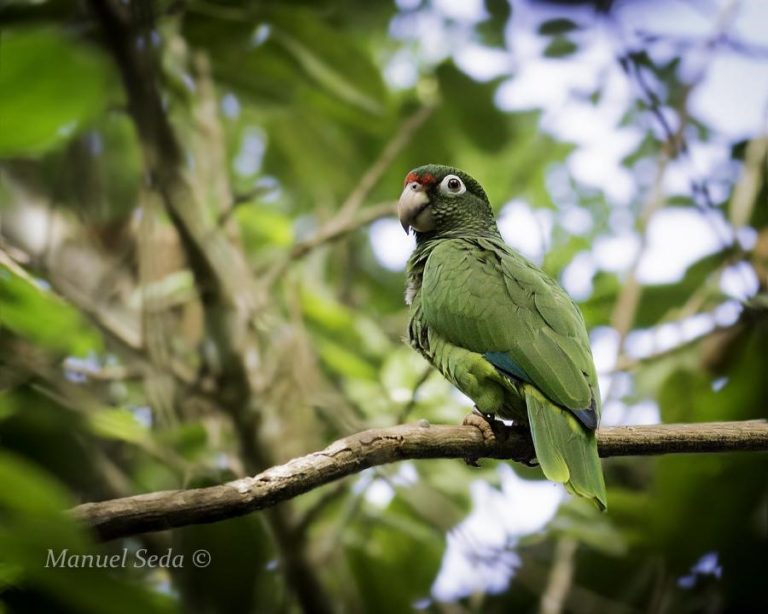
Puerto Rican Parrot. (Río Abajo State Forest, Puerto Rico; November 7, 2015.) © Manuel Seda
Notes
Monotypic species. A second, smaller subspecies, gracilipes, was endemic to Culebra, but was last seen in 1912 and is certainly extinct.
IUCN Red List Status: Critically Endangered.
Decline and Recovery of the Puerto Rican Parrot.
Historically described as having been abundant throughout Puerto Rico’s forests, the Puerto Rican Parrot declined precipitously during the 1900s and reached its all-time low in 1975 when a single flock of thirteen birds persisted in the Luquillo Mountains. That flock inhabited a small, remote area within El Yunque National Forest, and became the core of a U.S. Fish & Wildlife Service (FWS) recovery program.
FWS established a captive breeding facility at El Yunque and released birds locally to rebuild the wild population. Efforts to restore the El Yunque flock have had mixed results: periods of slow growth punctuated by sharp losses to hurricanes. In 1989, Hurricane Hugo cut the wild population roughly in half, from about 47 to 23. Over the years, numbers at El Yunque fluctuated in the range of 20 to 60, with all known recruitment coming from the captive-bred stock.
In 2006, FWS began to establish a second free-flying flock 70 miles west at Río Abajo State Forest to reduce the species’ vulnerability to catastrophic events. At Río Abajo, the parrots have fared better than at El Yunque, nesting naturally and showing signs of potential to become a self-sustaining population. With hopes of establishing a third population, FWS began releasing birds at Maricao State Forest in 2016, but thus far those releases have not succeeded.
In August 2017, before Hurricane María, the wild-living population was approximately 200 birds, with about 55 at El Yunque, 140 at Río Abajo, and three at Maricao. Following Hurricane María’s devastation of eastern Puerto Rico, the status of the species at El Yunque is uncertain, except that it includes revival of the captive breeding program. The hurricane had a much lighter impact on the forest at Río Abajo, and it appears that both the captive and wild flocks survived largely intact.
References
BirdLife International. 2016. Amazona vittata. The IUCN Red List of Threatened Species 2016: e.T22686239A93104104. http://dx.doi.org/10.2305/IUCN.UK.2016-3.RLTS.T22686239A93104104.en. (Accessed November 15, 2017.)
Forshaw, J.M. 2010. Parrots of the World. Princeton University Press, Princeton, N.J.
Raffaele, H. 1989. A Guide to the Birds of Puerto Rico and the Virgin Islands. Princeton University Press, Princeton, N.J.
Raffaele, H., J. Wiley, O. Garrido, A. Keith, and J. Raffaele. 1998. A Guide to the Birds of the West Indies. Princeton University Press, Princeton, N.J.
U.S. Fish and Wildlife Service. 2017. Puerto Rican Parrot (Amazona vittata) 5-Year Review: Summary and Evaluation. https://ecos.fws.gov/docs/five_year_review/doc5215.pdf.
U.S. Fish and Wildlife Service. ECOS Species Profile for Puerto Rican Parrot (Amazona vittata): https://ecos.fws.gov/ecp0/profile/speciesProfile?spcode=B00L.
